Mid-East 'Oil Shock' Rattles Global Stock Markets, Energizes Gold
Commodities / Crude Oil Jul 23, 2006 - 09:35 PM GMTBy: Gary_Dorsch
Since withdrawing its troops from Southern Lebanon six years ago, Israel has carefully watched Iranian backed Hizbollah guerillas plant landmines and booby traps along their common border, and then stockpile about 12,000 katushya rockets, with ranges up to 100 km (60 miles), aimed at Israel's northern frontier. Until July 12 th , the prevailing view in Jerusalem was that Hizbollah would hold its fire, unless a wider war in the Middle East broke out over Iran's clandestine nuclear program.
However, the Middle East tinderbox was set on fire on July 12 th , when Hizbollah guerillas sneaked across the border and killed eight Israeli soldiers and kidnapped two others, which Israel's prime-minister Ehud Olmert called an “act of war”, and promised a "very painful and far-reaching" response. Hizbollah is the only Lebanese faction to retain its weapons after the 1975-90 civil-war, and is also a political party, with 14 members in the Beirut parliament and two cabinet ministers.
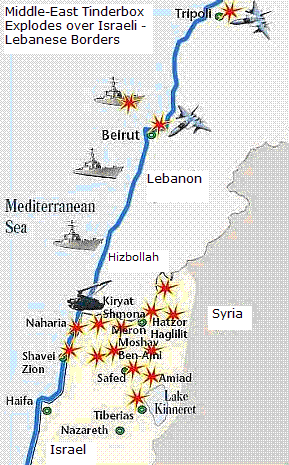
| Hizbollah crossed another "red line" on July 16 th with a rocket attack on Haifa, Israel's third largest city, 35 km (20 miles) south of the Lebanese border. If Hizbollah launches longer-range Iranian missiles on Tel Aviv, the commercial center, the Israeli response would be very severe. The next few days are most critical and a lot depends on whether Tehran decides to take a chance and authorizes Hizbollah to launch long-range missiles with more powerful warheads at Israeli cities. Neither side has yet played its full hand. Israel did not knock out Beirut's electrical grid, as it had done in the past. Hizbollah has not yet aimed at the oil refineries and other combustible targets in the Haifa Bay area, or unleashed its longest-range rockets reportedly capable of reaching Tel Aviv. It is difficult to assess what the Iranian leadership will decide next in its war to “wipe Israel off the map.” But if Iran and Syria join the battle, world oil prices could soar, and meltdown the global stock markets. |
The G-8 leaders meeting in St Petersburg, blamed Hizbollah for the flare-up of violence, and agreed that Israel had the right of self-defense. That gives Israel the green light to maintain its air, land, and sea blockade of Lebanon, to prevent further shipments of ammunition to Hizbollah. An extended blockade might also convince the Sunnis, Druze, and Christians that Hizbollah is not the protector of Lebanon from Israel, as it claims, but a terrorist proxy, operating at the behest of Iran and Syria that will bring disaster upon Lebanon's economy and infrastructure. However, Saniora's Sunni Muslim-led government is not willing to use force against the Shiite Muslim Hizbollah guerrillas, which could trigger another bloody civil war in Lebanon. The 70,000-strong Lebanese army would break up along sectarian lines, as it did during the 1975-90 civil-war. Such an option is therefore, highly unlikely.
Fears of a Wider War in the Middle East Very few traders took Iranian President Mahmoud Ahmadinejad seriously on July 9 th , when he called for a jihad against Israel. “The basic problem in the Islamic world is the existence of the Zionist regime, and the Islamic world and the region must mobilize to remove this problem. The biggest threat today for the region is the existence of the fake Zionist regime, and it will not be long before intense Muslim fury will lead to a huge explosion," he said. Three days later, on July 12 th ,
Hizbollah heeded the call with a cross border raid into Israel that coincided with a deadline for Iran to respond to a UN package of carrots and sticks relating to its nuclear program. Ahmadinejad rejected the deadline in no un-certain terms on July 13 th . "In the face of the venomous campaign of malicious people, we'll not step back one iota. The Iranian people are standing tall on their way to access their full rights and complete use of the nuclear fuel cycle." The flare-up of violence distracted the Group of Eight summit of major world powers, which had planned to focus on a joint policy on Iran's nuclear program, and eventual UN Security Council sanctions, if it doesn't suspend uranium enrichment. Instead, the G-8 leaders spent much of the weekend struggling to reach a semblance of consensus on how to stop the new violence. 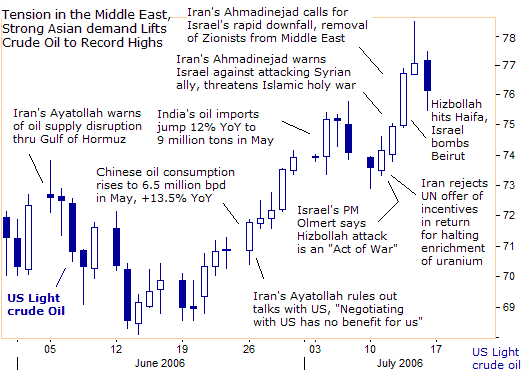
The flare-up of violence briefly sent US light crude oil soaring to record highs of $78.40 per barrel on July 14 th , and crude oil for April 2007 delivery hit $80 per barrel. Iran's Ayatollah figures the US or Israel might someday launch a preemptive strike again his nuclear facilities. So Hizbollah's attacks might just be a sneak preview of the damage that Tehran can inflict on Israel and the global stock markets, if the UN embargos Iranian oil exports or blocks its imports of gasoline. Fanning the flames of a wider war in the Middle East, on July 13 th , Iran's Ahmadinejad warned Israel against attacking Syria, during a telephone call with President Bashar al-Assad in Damascus. "If Israel commits another act of idiocy and attacks Syria, this will be the same as an aggression against the entire Islamic world and it will receive a stinging response,” he warned.
On July 16 th , Hizbollah leader Sheikh Hassan Nasrallah warned that the Iranian proxy could strike almost anywhere in Israel. “We are just at the beginning. We promise them surprises in any confrontation. Hizbollah is not fighting a battle for Lebanon. We are now fighting a battle for the Islamic nation. The peoples of the Arab and Islamic world have a historic opportunity to score a defeat against the Zionist enemy. We are providing the example," Nasrallah added. But Saudi Arabia rejected Hizbollah's call for jihad on July 14 th , “there has to be a differentiation between legitimate resistance to Israel and uncalculated adventures. The kingdom sees that it is time for those elements to alone shoulder the full responsibility for this irresponsible behavior and that the burden of ending the crisis falls on them alone.”
With the Saudis publicly distancing themselves from Hizbollah, and Egypt and Jordan sharing similar private sentiments, the current crisis leaves Israel alone, to square off against the Hizbollah, Syrian, and Iranian axis. The “Oil Weapon” and the Laws of Supply and Demand Tehran has already unleashed the “Oil Weapon” this year with daily verbal jawboning threats, and without cutting back a single barrel of oil exports. On June 4 th , the Ayatollah Khameinei threatened to disrupt the flow of 17 million barrels per day thru the Gulf of Hormuz, lifting crude oil above the psychological $70 per barrel area. "If the US makes a wrong move regarding Iran, definitely the energy flow in this region will be seriously endangered," Khamenei warned. Iran's chief nuclear negotiator Ali Larjani said the US is intent on toppling Tehran's government whatever happens in talks over its nuclear plans, Britain's Guardian newspaper reported on June 23 rd . “If the Americans continue on the same path, the price of oil will skyrocket and it will strengthen our resolve. They want to set fire to the region. The American strategy is to use force to secure their interests.”
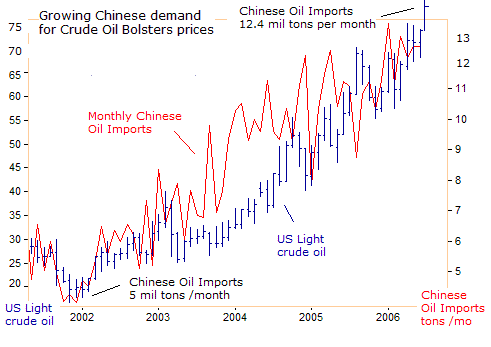
There is also growing demand for crude oil in China and India that keeps oil prices bubbling. China's crude oil imports for the first five months of 2006 were up 17.9% at 12.4 million tons, importing more than 40% of its crude needs. India's oil imports rose to 9 million tons or 12% higher from a year ago, and its industrial production was up 10% in May from a year earlier, bolstering its oil demand. Also squeezing the price of crude oil higher was a report from London, that supplies of North Sea Brent that set the price for a quarter of the world's oil supply will fall to a record low of 741,000 barrels per day in August, down from 933,000 bpd in July due to maintenance on Forties fields. In Nigeria, suspected explosions at oil pipelines on July 13 th heightened uncertainty over production, even as almost a quarter of oil output in that country remains shut due to attacks by militants.
.gif)
In the United States, the world's largest oil consumer of 21 million bpd, the price of crude oil briefly rose to an all-time high of $78.40 per barrel in electronic trading on July 14 th . The uptrend in crude oil has confounded market bears, because prices are climbing alongside a 25% increase in US commercial oil stocks from two years, to an eight year high of 347 million barrels in June. In the past two weeks however, US crude oil stocks fell 3% or 11 million barrels to 336 million barrels. US oil companies are hoarding oil supplies, in case Iran withholds crude-oil exports or targets oil tankers in the Persian Gulf. Iraq is falling into a civil war and its daily oil output of 2.4 million bpd is unstable. And now China has just completed oil storage tanks in Zhejiang, Shandong and Liaoning, with capacity to hold up to 88 million barrels, and is planning a third phase of yet another 200 million barrels of storage, to be completed by 2008.
The nightmare scenario of $100 per barrel is a possibility, but mitigating the odds are total government and industry stocks of crude oil and refined products held by member states of the OECD, that amount to about 4 billion barrels. If markets do not settle down from a possible cut-off in Iranian supply, there are reserves available to cover the Iranian shortfall for several years. And without its $54 billion of annual oil sales, Iran's economy could collapse and topple the Ayatollah's regime. Mid-East Oil Shock Rattles Dow Jones Industrials One year ago, with crude oil trading at $62 /barrel, former Fed chief “Easy” Al Greenspan was marveling at the strength of the US economy and the stock market, in defiance of record high oil prices. “The increase in oil prices since the end of 2003 probably shaved roughly 0.50% off of real GDP growth last year, and they look to restrain growth this year by approximately 0.75%. Aside from these headwinds, the US economy seems to be coping pretty well with the run-up in crude oil prices.”
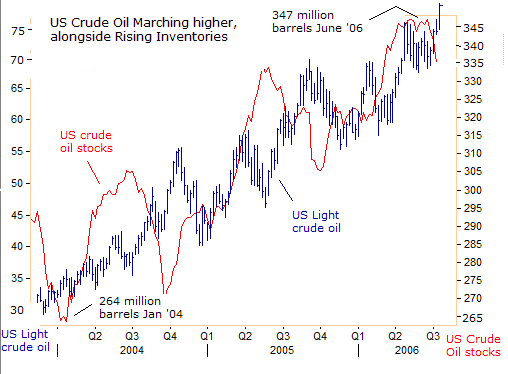
But eleven months later, on June 7 th , Greenspan offered a grim view of the world's vulnerability to crude oil prices above $70 per barrel. “The energy abundance on which this nation was built is over. While the world economy had largely shrugged off sharp oil price gains so far, the immunity of US consumers may be running out. The US especially, has been able to absorb the huge implicit tax of rising oil prices so far. However, recent data indicate we may finally be experiencing some impact.” Greenspan said the buffer between oil supply and demand was razor thin and that oil price spikes remained a risk. "Even small acts of sabotage or local insurrection have a significant impact on oil prices.” He added that a big oil price rise could spur "a significant contraction in the economy," but said he could not predict what size increase it would take to do such damage.
In retrospect, the surge in oil prices above $70 per barrel was the trigger point that derailed the 3-year Dow Jones Industrials rally. For the eternal optimists on Wall Street, the bargain hunters who dive into the market to buy badly stocks after any big sell-off, the latest oil price shock is no fluke and much higher energy prices could lie on the horizon, if the Ayatollah shuts down the Strait of Hormuz. Before that happens however, schizophrenic US hedge fund traders, whose firepower rocks markets at a moment's notice, will focus on Fed chief Ben Bernanke's testimony before Congress on July 19 th .
Bernanke has zig-zagged a few times in the past three months, between calls for a pause, then calls for rate hikes, to confront inflation pressures. After the latest downturn in the US stock markets, the odds in the fed funds futures market are 50-50 for a rate pause in August. European Central Banks Shaken by Middle-East Oil Shock Just when Europe's largest economy was gaining upward momentum after 3-years of flirting with recessions, the Middle-East oil shock threatens to derail Germany's long awaited recovery. German factory orders jumped 17.3% from a year earlier in May, the biggest increase since 2000. The Munich-based Ifo institute raised its 2006 growth forecast for the German economy to 1.8% and the business confidence index unexpectedly surged to a 15-year high. Germany's $2.6 trillion economy and the DAX-30 blue-chips have depended on foreign sales over the past four years for growth, as job cuts at home and a surge in oil prices eroded households' purchasing power. About one third of Germany's overall economy is linked to exports, which were booming in April and May at an average of 73 billion Euros, but are at risk from any global economic downturn.
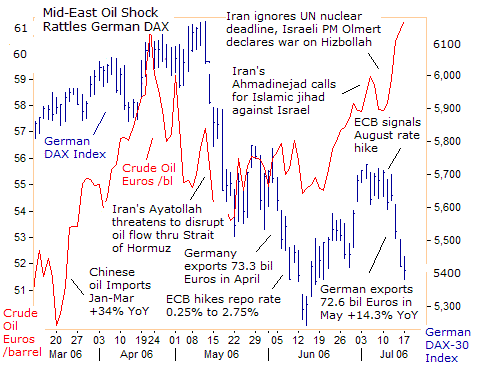
The first oil shock in early April to as high as 61 Euros /barrel, flattened the high-flying German DAX-30 index, which was racking up a 42% gain from a year earlier, fueled by merger and takeover mania in Europe. But the first spike in oil prices to 61 Euros per barrel also began to show up in the German producer price index, which jumped 0.6% in April, to an annualized 6.2%, its highest rate in 24-years. The Middle-East oil spike to 61 Euros per barrel on July 14 th , also derailed a German DAX's recovery at the 5700-level, and overshadowed bullish news that Germany exported a near-record 72.6 billion Euros in May. Germany is the world's fourth largest oil importer of 2.4 million bpd of oil, with the largest source of crude oil imports from Russia, Norway, and the United Kingdom.
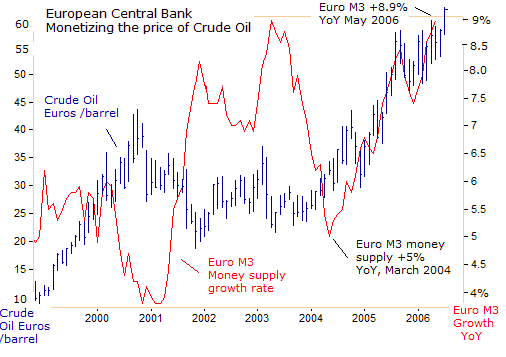
The sharp rise in world oil prices presents a big dilemma for the European Central Bank, which is inflating the Euro M3 money supply at an annualized 8.9% clip, to cushion the European stock markets from the rising costs of energy. The ECB's strategy is beginning to backfire, with European headline inflation rates creeping higher, due to the rising cost of oil and its secondary knock-on effects. On June 15 th , the Bank of Spain's chief Jaime Caruana broke ranks with ECB chief Jean Trichet, and called for a tighter ECB monetary policy to combat the rising cost of energy and other commodities. “The world economy has so far absorbed rising commodity prices well, but the upwards trend is a major risk to the world economy,” declared Bank of Spain chief Jaime Caruana on June 15 th . "This trend constitutes a risk of the first order to which monetary policy must remain vigilant”
On July 12 th , Jean “Tricky” Trichet agreed that high oil and commodity prices demanded closer attention, and should not be ignored when measuring true inflation levels in the Euro zone. “The phenomenon we are observing is very important and we have to understand it. We are in some kind of supply shock, but also very much a demand shock with the emergence of new economic giants, (China, India),” he said. Trichet then criticized the narrow focus on measures such as “core” consumer price inflation, which exclude rising energy costs but factor in the falling cost of manufactured goods. That would represent a 180 degree change in “Tricky” Trichet's view of inflation. But Trichet is still dragging his heels, and the ECB's three-quarter point rate hikes to 2.75% so far since December, have not kept pace with a 1.5% surge in the Euro zone producer inflation to 6.0 percent.
So on the surface, the ECB is raising nominal interest rates, but behind the “smoke and mirrors” the ECB's repo rate, adjusted for producer price inflation, is actually lower this year, at a negative 3.25 percent. An August rate hike to 3.00% would still leave the ECB far behind the inflation curve, especially during a Middle-East oil shock period. But then again, the ECB is also aiming to cushion European stock markets. Bank of England Monetizing Oil prices The Bank of England, has been conspicuously absent from the G-10's monetary tightening campaign this year, Instead, the BOE is quietly inflating the British M4 money supply at an annualized rate of 11.7%, twice the growth rate from three years ago, to insulate the British stock market from the shock of escalating oil prices. England finds itself today with crude oil prices at 42 pounds per barrel, up 133% from three years ago, yet the BOE has no intention of raising rates anytime soon.
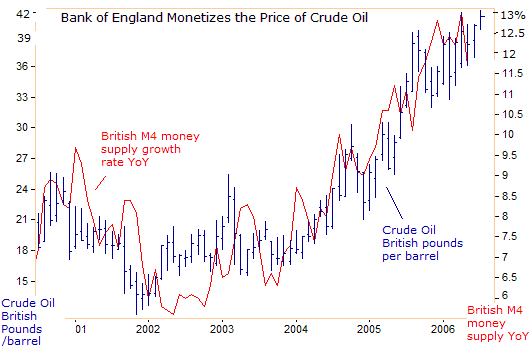
The BOE is defending the UK housing market, as British mortgage debt exceeds a trillion pounds for the first time in May, underlining the economy's vulnerability to any downturn in the housing market. Outstanding mortgage debt hit 1.06 trillion pounds in May as net lending surged by 9.3 billion pounds, the biggest monthly gain for 2-½ years. British consumers could find it increasingly difficult to stay on top of their debts if rates rise, so the BOE is printing more pounds to keep rates low.
Bank of Japan Tightening despite Oil Shocks The Bank of Japan's five-year, ultra-easy money policy was widely cited as a primary contributor to the bullish trend in global commodities, including copper, crude oil, silver, and zinc, over the past four years. The BOJ's ultra-easy money policy boomeranged with higher energy and metals costs, pushing Japan's producer price index up 3.3% in May from the same period a year earlier, its fastest in 25 years. According to the Bank of Int'l Settlements, in the seven quarters to the end of 2005, “yen carry” trades surged by $161 billion, with three quarters of this lending channeled to international financial centers such as the United Kingdom, Singapore, and the Cayman Islands, a favorite haven for hedge funds. Traders could borrow funds in Japan at zero percent to finance positions in commodities, while the Japanese ministry of finance was intervening or jawboning the yen lower.

Rising Japanese producer prices are a concern to the BOJ because they slow corporate profit growth, and add pressure on factories to pass along higher input prices to consumers. Tokyo says that “core” consumer prices are rising at a slower 0.6% rate in May, and that suggests that middleman profit margins are getting squeezed. Indeed, Japan's corporate profit growth slowed to 4.1% in the first quarter, less than half the 11% in the fourth quarter. Partly in response to soaring gold and commodity prices, the Bank of Japan announced the end of its radical “quantitative easing” policy on March 9 th , and has drained 22.7 trillion yen out of the banking system since March 9 th .
Japan's monetary base, which includes yen in circulation plus bank deposits, fell to 91.4 trillion yen last month. The BOJ also hiked its key overnight rate by 0.25% from zero percent on July 14 th , but added, "an accommodative monetary environment ensuing from very low interest rates will probably be maintained for some time.
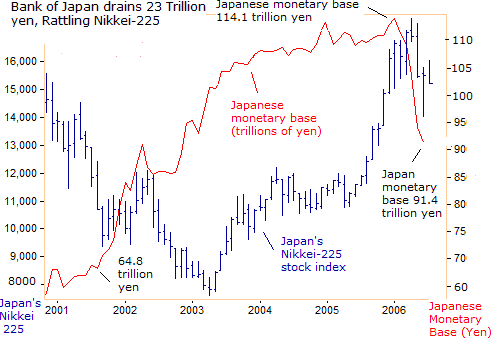
But while the baby-step rate hike to 0.25% is a noteworthy event, it's just part of a game of “smoke and mirrors”. After the dust finally settles, Japan's overnight loan rate is pegged at 3% below its producer price inflation rate. While the BOJ is tightening liquidity in a big way in the $4.5 trillion economy, a 0.25% overnight loan is still abnormally low, and is not likely to put a meaningful roadblock in front of “yen carry” traders betting on the long side of the “Commodity Super Cycle”.
The BOJ is still under enormous pressure from the finance ministry to keep its overnight interest rates close to zero percent. Tokyo has 774 trillion yen ($6.7 trillion) of outstanding debt, and doesn't want to pay a higher cost of servicing the debt. Finance Minister Sadakazu Tanigaki said on July 11 th, "It is desirable to have zero interest rates to support the economy when there are no worries about inflation. The BOJ needs to watch markets and the underlying economic conditions," he said.
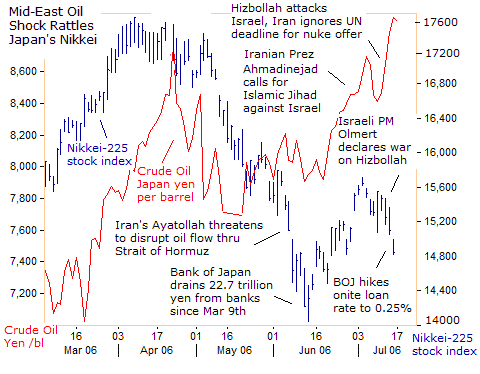
With Japan's Nikkei-225 stock index is starting to wilt under slowing profit growth and soaring oil prices to a record 9,000 yen per barrel on July 14 th , it's a good bet that the BOJ would remained sidelines for the next few months. Japan contains almost no oil reserves of its own (59 million barrels of proven oil reserves), but it is the world's third largest oil consumer, after the US and China. Japan consumes an estimated 5.35 million barrels per day.
Yet by leaving the overnight loan rate pegged at 0.25%, the BOJ hopes the cushion the Nikkei-225 from high oil prices. Gold Shines as a Hedge against Inflation Gold emerged as a big winner from the chaos in the Middle East, and the inflationary consequences of spiraling crude oil prices. Last week, the yellow metal defied a firmer US dollar and a plunge in global stock markets, and instead tracked crude oil. Traders feared the conflict in the Middle East could spread to include Iran and Syria and roil a region that supplies almost a third of the world's crude oil.
Most interestingly, the tight correlation between gold prices and the direction of global stock markets was broken in the past five days, as gold rose 8% towards $675 per ounce, while Morgan Stanley's World Index fell 3.3% to a three-week low. The MSCI World index measures blue chip stocks of 23 developed economies that account for 86% of the world economic output.
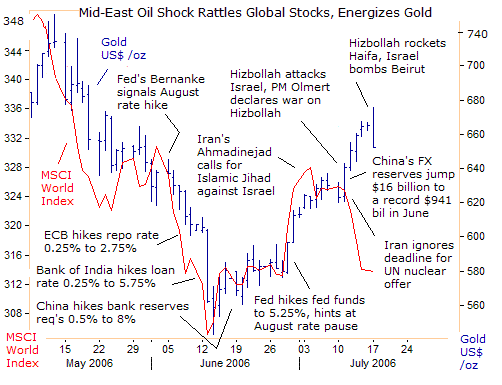
Since September 2005, gold and global stock markets were moving in lockstep. After-all, the direction of global stock markets can give real-time clues about the health of the global economy, the demand for commodities, and global inflation pressures.
With gold recovering two-thirds of its losses from May 11 th , the big-3 central banks face a quagmire of falling stock markets and rising gold prices, or the nightmare scenario called “Stagflation.” Also boosting gold was a report that China's foreign exchange reserves, the world's largest, rose by $56.2 billion in the first quarter and $66 billion in the second quarter 2006 to a record $941.1 billion. In all of 2005, they swelled by $209 billion. China's FX reserves have ballooned as the central bank prints yuan in exchange for foreign currency flowing into the country, in order to hold down the yuan exchange rate. But the flood of FX reserves is making it hard for the Chinese central bank to keep the money supply under control. Beijing issues treasury bills to drain the excess cash, but must pay interest on the debt. Meanwhile, Yu Yongding, who advises the People's Bank of China, wants to use the foreign-currency reserves, to buy gold and crude oil as a hedge against inflation and the eventual devaluation of the US dollar against the yuan.
The PBOC has only 1% of its reserves in gold. Tel-Aviv Stock Exchange under Attack Not surprisingly, the Tel-Aviv-25 stock index took it on the chin last week, after Israel suddenly found itself in a new war with Iran's Hizbollah in Lebanon. The TA-25 tumbled 10% in three days, amid worries that prolonged fighting would force the Treasury to run a bigger budget deficit, driving up long term Israeli bond yields. Israel's economy grew by an impressive 6.6% in the first quarter, but could get hurt by soaring crude oil prices and rate hikes in Japan and Europe. At its worst level on July 17 th at the 720-level, the TA-25 was off 20% from its all-time high of 900 set in early May. After a reversal bottom pattern set on July 17 th to the 770-level, the TA-25 was back in perfect alignment with Morgan Stanley's emerging market index. The reversal bottom for the TA-25 was based on speculation that the battle with Hizbollah would not spread to Syria or Iran.
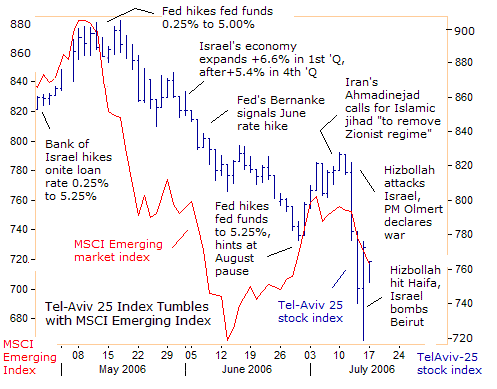
Israelis are resilient and accustomed to fighting wars with their Arab neighbors every few years, in addition to the daily battles with Hamas and Islamic Jihad. Yet the Israeli economy grew 4.3% in 2004 and 5.2% in 2005, and is expected to grow 5% in 2006. Until May 11 th , the TA-25 had tripled in value from three years ago, far outpacing stock markets in developed countries. Israel attracted a record $9.7 billion of foreign investment last year, and is on course to raise $1.6 in venture capital for its high-tech industries in 2006. Twelve business groups control 60% of the aggregate market value of all Israeli public companies (when Teva Pharmaceutical Industries is excluded), with shares valued at $44 billion. The groups achieved their control through descending layers of ownership.
These types of organizations were eliminated in the US in the 1930's, through a series of restrictions on ownership, as well as double taxation of dividends paid by a company to its parent organization. As for the future of the TA-25, Israeli traders are already looking beyond the skirmish in Lebanon and focusing on fundamentals, such as interest rates, oil prices, earnings, and the direction of other emerging stock markets. Israel's military said it destroyed 30% of Hizbollahs's weaponry so far, and expects to knock out the remainder by next week, leading to the departure of Sheik Nasrallah from Lebanon. Beirut Stock Exchange Locked Limit down Lebanon's stock market did not open on July 17 th , after tumbling 14% last week, after the Israeli blockade closed down the Lebanese economy and all its foreign trade. Lebanese Finance Minister Jihad Azour explained the market would be closed for security reasons, though trading would continue in the Lebanese pound. On the currency front, big investors are converting to the US dollar from the Lebanese pound, but so far, there has been no major flight of capital.

Azour said the central bank has around $13 billion in gross foreign currency reserves, more than enough resources to defend the pound. However, if the Israeli blockade is prolonged for several months, the central bank might run out of cash, raising doubts about its ability to service Lebanon's huge foreign debt burden. That in turn, could sink the pound, trigger higher inflation and higher interest rates, and crush the Beirut stock market when it dares to re-open for trading.
Meanwhile, the Lebanese economy will suffer from the attacks on infrastructure. Booming tourism has played an important part in Lebanon's economic recovery, with the bulk of its tourists from the Persian Gulf region. But the severity of the current disruption will depend on how long the Israeli attacks continue and how long it takes for damage to be repaired, all of which is currently uncertain. Israel has threatened to destroy Lebanon's electricity grid, if Iran's Hizbollah fires upon Tel-Aviv.
Istanbul swept lower by Regional contagion The main Turkish share index, the Istanbul-100 fell as much as 4.8% on July 17 th , while the lira and Turkish bonds weakened with losses in other foreign markets. Violence between Turkey's southern neighbors in Israel and Lebanon has escalated, increasing investors' fears that the situation could erupt into regional violence. Tourism to Turkey was already 16.7% lower in May from a year earlier. The Turkish stock market was hammered in the global emerging stock market meltdown between May 11 th to June 13 th . The lira tumbled by 25%, forcing the central bank to hike its overnight lending rate in rapid succession by 425 basis points to 22.25%. The weaker lira is expected to lift Turkey's 10.1% inflation rate in the months ahead, and put a strangle hold on the Turkish stock market.
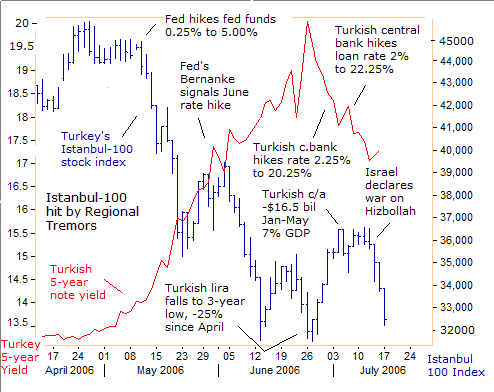
Turkey's current account deficit rose 73.8% year-on-year to $4 billion in May, and for the first five months of the year, the deficit stood at $16.5 billion, compared with a deficit of $11.2 billion in the same period a year earlier. Turkey revised its official estimate of the deficit to 7% of gross national product from an original 5.8 percent. Turkish GNP is projected at $381 billion in 2006. Turkish oil demand is around 685,000 barrels per day, and 90% of Turkey's oil supplies are imported, mainly from Saudi Arabia, Iran, Iraq, Syria and Russia. Turkey's port of Ceyhan is a major outlet for Iraqi oil exports, with optimal pipeline capacity from Iraq of 1.6 million bpd. But higher oil prices can widen Turkey's trade deficit which mushroomed 36% to $21.6 billion in first five months of 2006, from the same period a year ago.
With the flare-up of violence in the Middle-East and surge in crude oil prices to $78 /barrel, there are doubts about Turkey's ability to attract enough money from abroad to cover its external deficit. In an attempt to stop the capital flight, Turkey will scrap a 15% withholding tax on non-residents investing in financial instruments, said Finance Minister Kemal Unakitan on June 22 nd . The withholding tax for Turkish residents investing in shares and bonds will fall to 10% from 15 percent.
To Subscribe to the Global Money Trends newsletter, Please click on the hyperlink below to place an order now. http://www.sirchartsalot.com/newsletters.php
Disclaimer: SirChartsAlot.com's analysis and insights are based upon data gathered by it from various sources believed to be reliable, complete and accurate. However, no guarantee is made by SirChartsAlot.com as to the reliability, completeness and accuracy of the data so analyzed. SirChartsAlot.com is in the business of gathering information, analyzing it and disseminating the analysis for informational and educational purposes only. SirChartsAlot.com attempts to analyze trends, not make recommendations. All statements and expressions are the opinion of SirChartsAlot.com and are not meant to be investment advice or solicitation or recommendation to establish market positions. Our opinions are subject to change without notice. SirChartsAlot.com strongly advises readers to conduct thorough research relevant to decisions and verify facts from various independent sources.
21/8/06 - Is the “Commodity Super Cycle” Fizzling Out?
By Gary Dorsch, Editor – Global Money Trends newsletter
Since reaching a 25-year high of 365.45 on May 11 th , the Reuters Commodity Index, (CRB index), has been showing signs of fatigue, after a relentless four-year climb. The CRB index doubled from four years ago, led by commodity superstars, such as crude oil, copper, gold, platinum, silver, and sugar. However, since topping out three months ago, the CRB index has slumped about 9%, whipping up speculation that the “Commodity Super Cycle” is fizzling out.
Defending its decision to pause its two-year rate hike campaign at 5.25% on August 8 th , the Federal Reserve predicted that a softer US economy would take the steam out of commodity prices. “Inflation pressures seem likely to moderate over time, reflecting contained inflation expectations and the cumulative effects of monetary policy actions and other factors restraining aggregate demand,” the Fed said. Putting his fragile reputation on the line, Fed chief Ben Bernanke hinted at a rate pause on July 19 th , despite elevated commodity prices. “The recent rise in inflation is of concern, and possible increases in the prices of oil as well as other raw materials remain a risk to the inflation outlook. On the other hand, a slowing economy should reduce inflation pressures,” he told lawmakers on Capitol Hill. 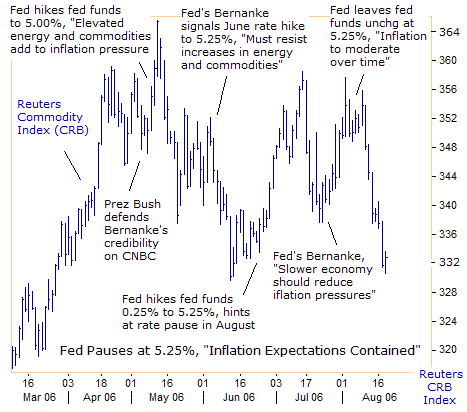
The Reuters CRB index has see-sawed since July 19 th , when Bernanke predicted a slower US economy would contain inflation pressures. Initially, the Reuters CRB index rallied 5% to the 355-level ahead of the Fed's August 8 th meeting. However, schizophrenic commodity traders decided to dump the Reuters CRB index after the Fed meeting, knocking the index 6.5% lower to the 332-level, a two month low. Bernanke's reputation hangs in the balance, subject to the whims of CRB traders. The Fed is betting that a slowdown in the US economy, can keep the “Commodity Super Cycle” under wraps.
If commodity prices are confined into a sideways trading range for an extended period of time, the year-over-year comparison of inflation readings would start to look good. The US economy slowed to a 2.5% annual growth rate in Q2, after sizzling at 5.6% in the previous quarter. Also, Labor Dept apparatchniks have reported US producer prices rose a scant 0.1% in July. Bernanke has authorized three quarter-point rate hikes to 5.25% under his tenure as Fed chief, attempting to transform his reputation from a super-dove into a wise old owl on monetary policy.
The Fed has reached the limits of its tightening campaign, fearful of tilting the US housing market into deflation. Americans are expected to draw $257 billion of wealth out of their homes this year, according to Freddie Mac, and higher rates would put further strain on their budgets and spending.
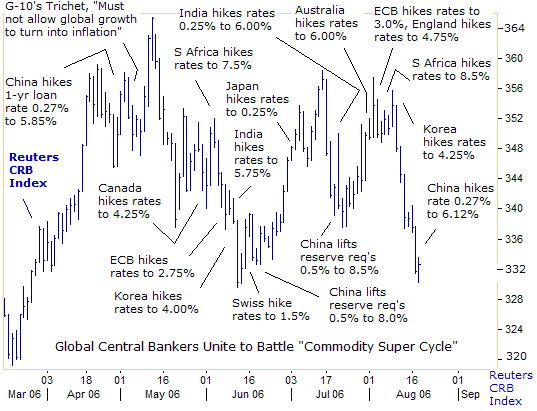
Fortunately, the Fed is getting outside support in the battle against the “Commodity Super Cycle.” With the Fed moving to the sidelines on June 29 th , other central banks from around the globe are picking-up the slack with baby-step rate hikes, or other methods of tightening global liquidity. Foreign central bankers do not want to see the Fed tilt the US economy into recession with a too tight money policy, which could hurt undermine the global economy, and hurt exports to the US market.
Most notably, the Bank of Japan (BOJ), the European Central Bank (ECB), the Bank of England (BOE), the Bank of Australia (RBA) the People's Bank of China (PBoC), the Bank of India (RBI), the Swiss National Bank (SNB), the Reserve Bank of South Africa (RBSA), and the Bank of Korea (BoK), have all stepped up to the plate to raise short-term interest rates over the past three months. The concerted round of central bank rate hikes are starting to wear down the “Commodity Super Cycle,” and more rate increases look likely in Australia, China, the Euro zone, England, Japan, South Africa, and Switzerland by year's end. It's probably fair to say, that the legion of 8,800 hedge funds, which control $1.2 trillion, are losing their speculative appetite for commodities, as global interest rates rise, and were behind the August sell-off in the Reuters CRB index.
Fed's Hands are Tied by Weak US Dollar, Chinese Yuan to Rise
Yet higher interest rates outside the US, combined with a steady Fed policy, might erode the value of the US dollar, and ironically, provide a floor for the Reuters CRB index. So while the Fed's rate hike cycle has probably peaked, the US central bank cannot afford to lower the fed funds rate anytime soon, to defend US homes prices, without triggering a rout of the US dollar. The Fed must wait for the Reuters CRB to fall sharply under its own weight first, before contemplating a rate cut.
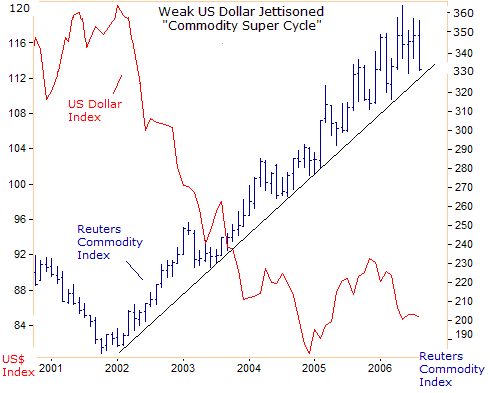
Meanwhile, the US dollar could tumble against Asian bloc currencies, once Beijing loosens its grip on the dollar /yuan peg. US Senators Schumer and Graham are pushing ahead with legislation to impose a 27.5% duty on China's imports, with a vote set for September 30 th , without opposition from new US Treasury chief Henry Paulson. This time, the US Congress is probably serious, and Beijing won't call Schumer's bluff, and therefore allow the US dollar fall to 7.75 yuan or lower, enhancing its purchasing power for global commodities. “China should reconsider its gradualist approach to the appreciation of the yuan,” said He Fan on July 28 th , chief economist at the Chinese Academy of Social Sciences, the government's top think-tank. “Developing a foreign exchange system cannot be accomplished overnight, but the level of the foreign exchange rate can be adjusted overnight.” He Fan said the experience of Japan, South Korea and Taiwan had shown that the economic impact of a rising currency was milder than expected.
Bank of Japan takes the Lead in battle against “Commodity Super Cycle”
Perhaps, the Bank of Japan's dismantling its ultra-easy money policy since March 9 th , has been the biggest stumbling block for the “Commodity Super Cycle” this year. Japan's monetary base, the money in circulation plus bank deposits at the BOJ, has plunged from 114 trillion yen ($982 billion) to 90.5 trillion yen ($780 billion) since January, while the BOJ drained massive amounts of excess funds out of the Tokyo money markets, and then lifted its overnight loan rate to 0.25% on July 14 th .
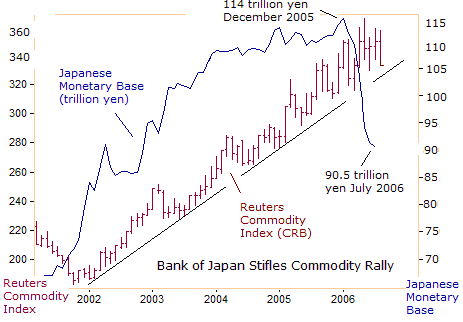
While draining roughly $200 billion out of the Tokyo money market, Japanese traders unwound over extended “yen carry” trade positions, where traders borrowed yen at zero percent to finance purchases of commodities, stocks, and emerging bonds, etc. The Bank of Japan is still on course to lift its overnight loan rate by 0.25% to 0.50% in the months ahead, regardless of the slowdown in Japan's economic growth rate to 0.8% in the second quarter, from 2.6% in the first quarter.
US and Japanese Bond Traders bet on a Peak in Global Inflation
In the US, bond traders are betting that the “Commodity Super Cycle” has topped out for 2006, signaling a peak in inflation, and in turn, the end of the bear market for US 10-year Treasury Notes. Since peaking at 5.25% on June 28 th , the US 10-year Treasury yield has declined by 40 basis points to 4.85%, with monthly US employment gains dropping by a third in Q2 from the previous quarter.
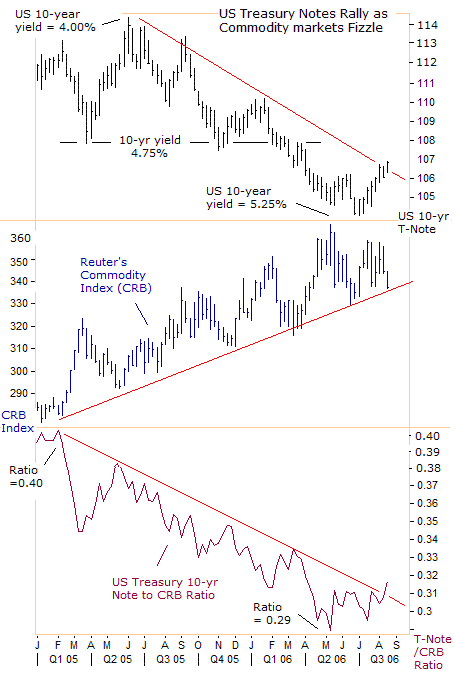
Since the Reuters CRB index topped out at the 365-level on May 11 th , the US T-Note-to-CRB ratio bottomed out at the 0.29-level, and has since turned higher towards the 0.3170-level. With the US T-Note-to-CRB ratio penetrating its downward sloping trend-line, US bond bulls are expressing supreme confidence that the US fed funds rate and 10-year yields have both peaked at 5.25%, and that the good-old days for the “Commodity Super Cycle” are fading into history.
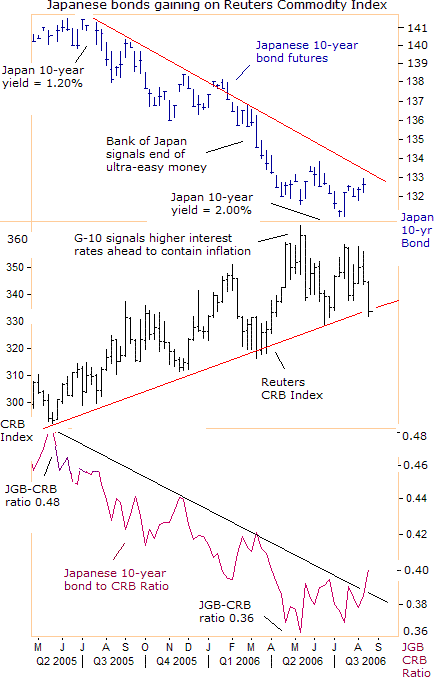
A similar bullish view is seen in Tokyo, with Japanese government bond (JGB) 10-year yields sliding to 1.83%, from as high as 2.00% on July 5 th . The JGB-to-CRB ratio hit bottom on May 11 th at the 0.36-level, and then penetrated a key downward sloping trend-line, mainly due to weakness in the Reuters CRB index, rather than strength in Japanese bonds. Japanese banks are holding a colossal 140.2 trillion yen ($1.2 trillion) of government bonds, roughly the size of Canada's economy, at yields that are far below Japan's 3.4% producer price inflation rate. Japanese bankers are anxious to unload over-extended JGB positions on decent rallies, blunting their upside potential, but an improvement in the JGB-to-CRB ratio might convince the BOJ to limit its rate hike campaign to 0.50% this year. That would leave negative interest rates in Japan, adjusted for inflation, which global traders can exploit for renewed “yen carry” trades in Nikkei-225 or foreign stocks, gold, silver, crude oil, emerging bonds, or any other asset play around the world.
China Embarks on a Tightening Campaign
Commodity traders keep close tabs on China's juggernaut economy, which expanded at an 11.3% annual rate in Q2, its fastest in a decade, for clues about global demand for commodities. The red-hot Chinese economy, single-handedly contributed 13% to global growth last year, and is the world's largest consumer of aluminum, copper, coal, iron ore, steel, buys 20% of the world's silver output, 6% of the global zinc supply, and is the second largest consumer of crude oil. China aims to build up strategic reserves of minerals such as uranium, copper and aluminum to help meet rising demand and provide a buffer against supply disruptions, the Ministry of Land and Resources said on May 10 th . Beijing has already started to build-up a strategic oil reserve of 80 million barrels, and aims to jointly invest with local companies to secure raw materials overseas to make sure the nation's metals needs are met over the next five years.
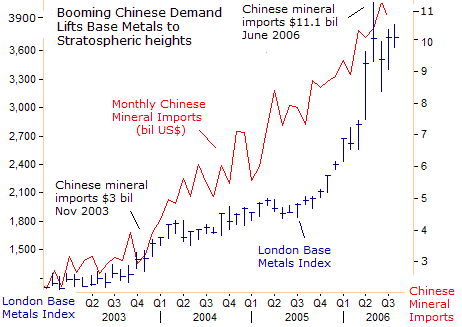
China's economy is riding a boom in exports and fixed-asset investment in factories, roads and housing, and has repeatedly defied expectations of a slowdown. Industrial production was 16.7% higher in June from a year earlier, as it becomes the world's manufacturing base, due to cheap labor and low taxes. Already, imports of minerals reached an all-time high of $11.1 billion in June, quadruple its demand from just three years ago. Base metal supplies are extremely tight, and high prices are boosting the fortunes of metal miners in Australia, Brazil, Canada, and Russia. China is the key engine of growth in Asia. Australia's exports to China soared 42% in the ten months to April 30 th from a year earlier, thanks chiefly to a 22% jump in exports of metal ores and minerals. Japan's exports to China jumped 26.1% to 4.9 trillion yen in the first half of 2006. Korean exports to China, which were growing at a rate in excess of 50% during 2004 and into 2005, have slowed to a pace of 12% in the first half of 2006.
China represents more than 20% of Korea's foreign sales. Any signs of a significant slowdown in China's economy would be of great interest to commodity speculators, government bond traders, investors in base metal miners, crude oil and gold dealers, and foreign central bank officials. On July 26 th , China's Premier Wen Jiabao issued a strongly worded warning about the dangers of economic overheating, and pledged to implement forceful tightening measures and improve the yuan's flexibility.
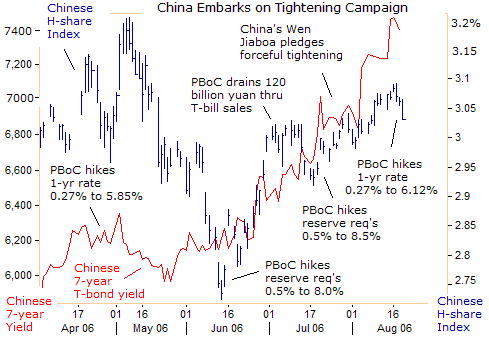
Jiaboa called for a crackdown on red-hot investment that could threaten the stability of the economy. “Fixed-asset investment growth, already rapid, is now accelerating. Growth in money supply and credit is still excessive, and the imbalance of international payments is intensifying. Forceful measures must be taken to help resolve the striking problems that exist, to prevent rapid economic growth from turning into overheating,” Jiaboa declared. Global traders have heard such bellicose declarations from Chinese leaders over the past two years, but the tough verbal jawboning was never backed up with action. However, the People's Bank of China shocked the markets on August 19 th , by hiking the benchmark one-year loan rate by 0.27% to 6.12%, and the five-year loan rate was jacked-up 0.45% to 6.84 percent. The PBoC aims to reduce the supply of middle to long-term loans that usually go on fixed asset investment. Preventing the economy from overheating has become the priority of China's economic planners in recent months. Inflationary pressures are ready to explode in China, with a fourth of manufacturing firms paying more for raw materials, especially crude oil. Employers hired new workers at the fastest pace in 16 months in July, exerting upward pressure on labor costs, which are bound to be passed along to consumers. The era of China exporting deflation could be history.
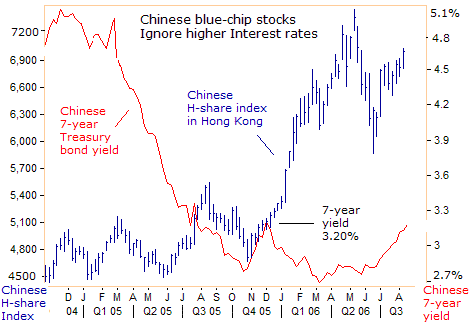
Yet despite the recent half-percent increase in the benchmark Chinese 7-year bond yield to 3.20%, mainland Chinese blue chip stocks traded in Hong Kong are within 4% of their all-time highs. Behind the PBoC's “smoke and mirrors”, it's quite evident that Chinese monetary policy has merely shifted from an ultra-easy policy to an easy policy, with the M2 money supply standing 18.4% higher from a year ago. Chinese 7-year bond yields still remain 2% below their levels of late 2004.
To avoid a hard landing in the juggernaut Chinese economy, the big-4 Asian central banks in China, India, Japan, and Korea are spreading the risk around, by tightening their monetary policies in synchronization. The Bank of Korea took the first step by hiking rates 0.25% to 3.50% in November 2005, and went to 4.50% on August 11 th . The Bank of Japan began to dismantle its five-year ultra-easy money policy in March, the Bank of China hiked its 1-year loan rate to 5.85% on April 24 th , and the Bank of India hiked rates in June and August to 6.00 percent.
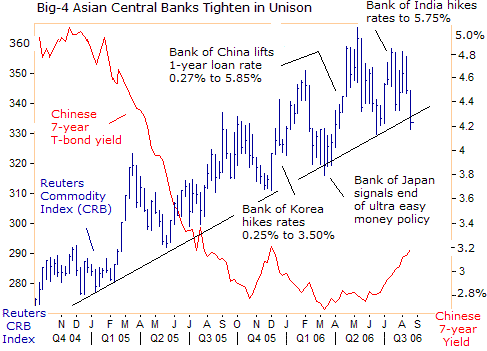
A hard landing in China would send tremors throughout Asia and rock far away places such as Germany, whose exports to China rose 28.1% in the first five months of 2006. But Beijing's leaders are moving cautiously, and simply aim to fine tune the economy towards a 10% growth this year. Still, the latest hike in Chinese interest rates would attract more “hot money” to the yuan, so the next phase of PBoC tightening might center on a yuan revaluation to 7.75 against the US dollar, a bullish factor for commodities in the longer term.
Crude Oil at the Crux of the Global Inflation
Higher crude oil prices give central bankers the biggest head-ache, because of their direct impact on producer prices and secondary knock-on effects on consumer prices. In Germany for instance, producer prices rose 0.5% in July or 6.0% higher from a year earlier, the highest rate in almost 24 years. Excluding energy however, prices rose by 0.5% compared with the previous month and 3.0% on the year. Energy and base metals prices were the biggest reason behind persistently higher German inflation rates. Energy prices increased by 1.0% in July and 15.6% from July 2005, and prices for non-ferrous metals jumped 6.2% on the month and 46.1% from a year earlier. Lead, zinc and tin was up 84.9% on the year and copper and semi-finished copper gained 82.8 percent.
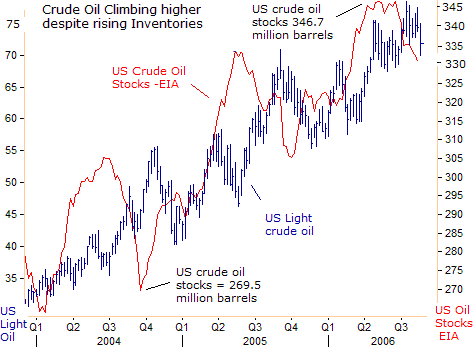
Since January 2004, US light crude oil prices have doubled towards $70 per barrel, even though oil inventories are 22% higher at 331 million barrels, defying the traditional laws of supply and demand. Instead, oil companies are hoarding their inventories, due to fear of future supply shocks, with a razor thin 2.2 million barrels per day (bpd) of global spare capacity, mostly from Saudi Arabia's heavy blend, which is difficult and costly to refine into gasoline.
The Iranian “War Premium” how long can it last?
Crude oil briefly dipped below $70 a barrel on August 18 th , and lost more than 4% for the week, pressured by a temporary truce between Israel and Iran's proxy army in Lebanon. However, crude oil has commanded an Iranian “war premium” of $10 to $15 per barrel for most of this year, as the world frets about the likelihood of a nuclear armed Iranian Shiite regime in the years ahead. On August 20 th , Tehran said it won't suspend uranium enrichment, turning down the main UN demand to prevent it from building atomic bombs.
Iran's defiance is based on a calculation that divisions at the United Nations mean it will only face soft sanctions such as travel restrictions on officials or asset freezes. The world's fourth largest oil exporter, flush with petrodollars, would gladly pay that price, in return for nuclear invincibility, domination of the Persian Gulf, and a world without Zionism. China and Russia are likely to veto any tough economic sanctions that could topple the Iranian Shiite regime, such as an embargo on gasoline sales to Iran, or blocking Iran's 2.4 million bpd of oil exports. Either of these two biting sanctions could cripple Iran's economy, which already suffers from a 12% inflation rate and a 20% jobless rate of workers below 30-years of age. Therefore, with no prospect of tough economic sanctions in sight, Iranian leaders have concluded that the only stumbling block to acquiring nuclear weapons and “wiping Israel off the map” is a pre-emptive US or Israeli aerial attack on its nuclear installations.
Therefore, on August 8 th , Yahya Rahim-Safavi, commander-in-chief of the Iranian Revolutionary Guards warned, “There is no doubt that if these criminals (US and Israel) attempt any operation or vicious assault, they will receive blows 100 times harder. They will not last against the raging sea of the Iranian people and the power of Islamic Iran," he said. Iran will hit Tel-Aviv with its medium-range missiles if attacked, said an influential senior cleric on August 15 th , “If they (US and Israel) militarily attack Iran, they should be afraid of the day when our missiles with 2,000 km range will hit Tel-Aviv," warned Ahmad Khatami, a key adviser to Supreme Leader Ayatollah Ali Khamenei. On August 11 th , Ahamadinejad denounced UN pressure as, “securing the interests that the Zionist regime would fail to secure through a military attack," he said.
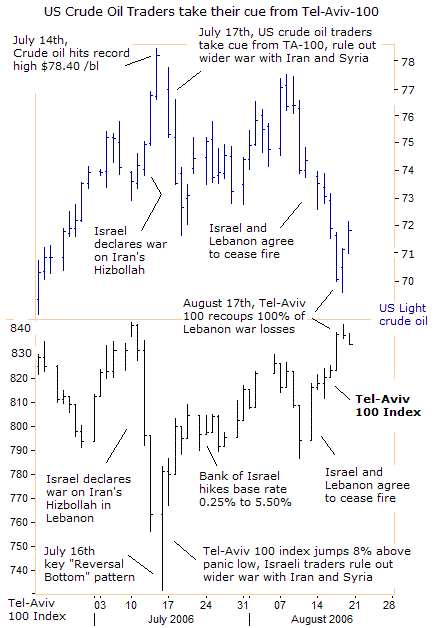
Because Tel-Aviv stood in the cross-fire of the Israeli–Hizbollah skirmish, US traders took their cue for the Tel-Aviv-100 index's “reversal bottom” pattern on July 16 th , which ruled out a wider war with Iran and Syria in the first round, and then dumped West Texas crude oil the next day, from a record high of $78.40 per barrel on July 14 th . The TA-100's recovery to the 840-level on August 17 th , where it stood on the eve of the Lebanon war, briefly knocked crude oil below $70 per barrel. But bullish Tel-Aviv traders might be living in a fool's paradise. On August 20 th , Israel MK Binyamin Ben-Eliezer warned that "the next round of fighting against Hizbollah could be held within several months. You have to read between the lines.
Hizbollah is getting organized, the Syria army is learning lessons. We have to rehabilitate the north, the reserve forces and the army and be prepared for the next round.” According to the London based Arabic daily al-Sharq al-Awast, Iranian Revolutionary Guards have already been dispatched to Syria and Lebanon to rehabilitate Hizbollah, and huge quantities of Iranian weapons have reached Damascus, and are waiting to be transferred to Lebanon. Turkey's Hurriyet newspaper said the Turkish military intercepted Iranian cargo planes carrying missile launchers and Chinese C-802 land-to-sea missiles, identical to the missile that hit an Israel Navy battleship in July. Lebanon's Druze leader Walid Jumblatt said in an August 21 st interview, “I see investigations inside Israel about the Israeli military's terrible performance. I see Ehud Olmert falling and Likud's Benjamin Netanyahu coming to power. There will be a second round of confrontations with Hizbollah and with other regional elements.”
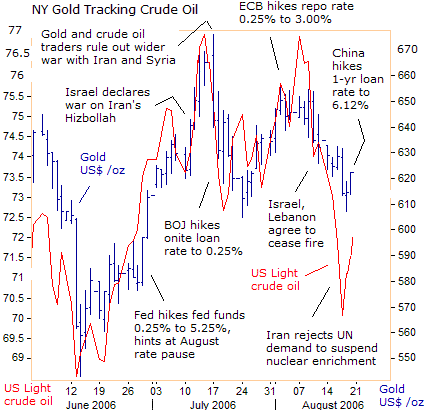
According to former Israel PM Benjamin Netanyahu, “the cease-fire that has been reached is merely an interlude because from Tehran's point of view, the war has to continue, first to achieve their goal of the destruction of Israel, and second to achieve their larger goal, the diminution, subjugation, and ultimately defeat of the West. So we're in a protracted battle, we just had the first round. More will come, and we'll have to prepare our force to overcome them,” he said on August 17 th . Accordingly, the price of crude oil is the major wildcard moving gold prices, the Reuters CRB index, and inflation expectations these days, and could wreck the best laid plans of central bankers to engineer a soft economic landing. It is short sighted to dismiss a second round of fighting in the Middle East, so both crude oil and precious metals could command “war premiums” in the months ahead.
Does a Top in Reuters CRB index Signal a Global economic slowdown?
Over the past few months, the Reuters Commodity index has suffered a series of body blows from 20 different central banks, but does its latest 5% decline signal a global economic downturn, or just the unwinding of over-extended speculative positions? Right now, the outlook is mixed. The Japanese and US economies shifted into lower gears in Q2, but China expanded 11.3%, it's fastest in a decade, and the Euro zone economy grew at a 2.4% annual rate, its best in six years.
Furthermore, the recent round of global rate hikes that have capped the Reuters CRB are deceiving, because global monetary conditions still remain super-easy. In China for instance, the M2 money supply is 18.4% higher, India's M3 is 19.1% higher, Korea's M2 is 9.2% higher, the UK's M4 is 14.1% higher, the Euro zone's M3 is 8.5% higher, and South Africa's M3 is 23.2% higher from a year ago.
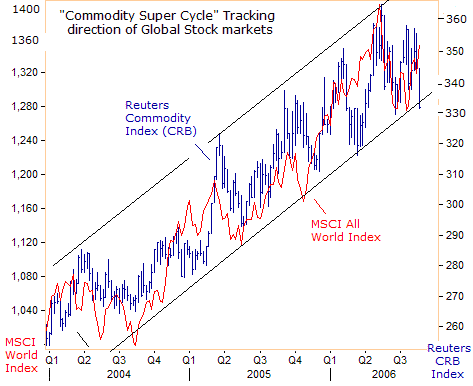
The European Central Bank targets its repo rate at 3%, far below Germany's 6% producer inflation rate, which in turn, encourages speculation in crude oil, base metals, and other key industrial commodities. In Japan, the BOJ's 0.25% overnight loan rate is far below the 3.4% PPI, and in the UK, the Bank of England's 4.75% base rate is roughly half of the annualized 9.6% factory price index.
The explosive growth of the global money supply in developed and emerging economies after 9/11, might explain the buoyancy of global stock markets at a time when sharply higher oil prices, would otherwise have been as a negative influence. For the past few years, the Reuter's CRB index has “followed the money” and tracked Morgan Stanley's All-World Index, for clues about the health of the global economy, consumer confidence, and in turn, the demand for commodities.
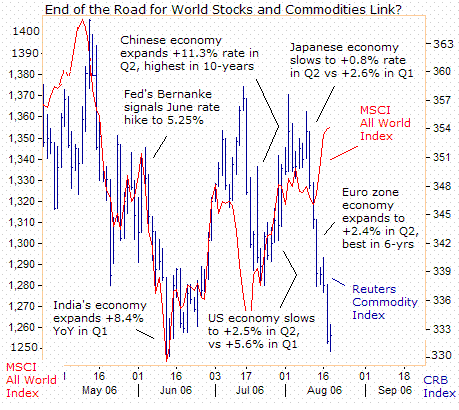
Last week however, the Reuters CRB index and the MSCI All-World stock went their separate ways, threatening the tight relationship between the two markets. Global stock markets rose, celebrating a 10% slide in crude oil prices towards $70 per barrel, while the CRB index was hammered due to its 45% weighting in energy and gold. Such divergences have popped-up from time to time however, but over the long-term, the close relationship hasn't ruptured into a full blow divorce.
A similar divergence developed in March 2006, when the CRB index fell 8%, while the MSCI all World index was left relatively unscathed. Two weeks later, the CRB index rebounded strongly and caught-up with elevated global stock markets. Most likely, the latest sell-off in the Reuters CRB is simply linked to the schizophrenic behavior of hedge fund traders, whose sentiment can turn on a dime, and short-sightedness that rarely projects beyond a week or just a few days.
If global stock markets stay elevated, projecting a stronger global economy, it's only a matter of time until traders recognize that pumped up money supplies and negative interest rates, are also bullish factors for commodities. Throw in a weaker US dollar, led by a stronger Chinese yuan, and a UN showdown with Iran in September, then the “Commodity Super Cycle” could recoup its August 9 th - 18 th losses, led by schizophrenic fund traders bidding crude oil and metals higher.
To read our analysis, forecasts, and inter-market technical charts for the Reuters CRB index, global interest rates, global stock market indexes, US-listed Exchange Traded Funds, foreign exchange rates, gold, copper, crude oil and other commodity markets, Subscribe to the Global Money Trends magazine . Please click on the hyperlink below to place an order now. http://www.sirchartsalot.com/newsletters.php
Disclaimer: SirChartsAlot.com's analysis and insights are based upon data gathered by it from various sources believed to be reliable, complete and accurate. However, no guarantee is made by SirChartsAlot.com as to the reliability, completeness and accuracy of the data so analyzed. SirChartsAlot.com is in the business of gathering information, analyzing it and disseminating the analysis for informational and educational purposes only. SirChartsAlot.com attempts to analyze trends, not make recommendations. All statements and expressions are the opinion of SirChartsAlot.com and are not meant to be investment advice or solicitation or recommendation to establish market positions. Our opinions are subject to change without notice. SirChartsAlot.com strongly advises readers to conduct thorough research relevant to decisions and verify facts from various independent sources.
© 2005-2022 http://www.MarketOracle.co.uk - The Market Oracle is a FREE Daily Financial Markets Analysis & Forecasting online publication.




